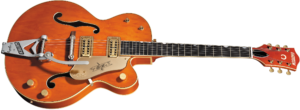One of the most important parts of great guitar production is also one of the most expensive… and thus… most overlooked part of home production for guitar tracks… the instrument. I’m sure we all know several sayings that boil down to, what you put in is what you get out… so paying close attention to what instrument we use is one of the first steps that needs to be considered when laying down keeper takes on guitar and bass.
 One of my guitars that has quickly become one of my favorites, and goto, guitars is my 1959 Gretsch 6120. This guitar was originally developed with Chet Atkins and is typically known for having a twangy vibe. The Gretsch 6120 pairs really well with my ‘65 Fender Twin and even Orange AD30. However, I’ve found the the Gretsch 6120 has become my goto guitar for lead Christian Rock. When I pair the 6120 with my Vox AC30 and sync my TapeDelay pedal… the sound is absolutely magical. You can hear this pairing on the Moment of Worship Winter & Summer worship 2016 albums.
One of my guitars that has quickly become one of my favorites, and goto, guitars is my 1959 Gretsch 6120. This guitar was originally developed with Chet Atkins and is typically known for having a twangy vibe. The Gretsch 6120 pairs really well with my ‘65 Fender Twin and even Orange AD30. However, I’ve found the the Gretsch 6120 has become my goto guitar for lead Christian Rock. When I pair the 6120 with my Vox AC30 and sync my TapeDelay pedal… the sound is absolutely magical. You can hear this pairing on the Moment of Worship Winter & Summer worship 2016 albums.
 One of the other guitars that you can find on almost all albums I’ve recorded this year (2016) is my 1995 Gibson J-200. This acoustic guitar sounds great on just about anything and everything and eventually was the goto guitar for Elvis Presley (how can you argue with that!?!?). As I mentioned before, I’ve laid down Gibson J-200 guitar tracks on just about every album I’ve written this year. However, it really took the front seat on the Across the Stateline album “Divided We Fall”. On this album you can hear the J-200 panned hard left/right on every track of the album. I typically will double track the Gibson J-200 and avoid phasing issues by changing the harmonics with my SSL preamps.
One of the other guitars that you can find on almost all albums I’ve recorded this year (2016) is my 1995 Gibson J-200. This acoustic guitar sounds great on just about anything and everything and eventually was the goto guitar for Elvis Presley (how can you argue with that!?!?). As I mentioned before, I’ve laid down Gibson J-200 guitar tracks on just about every album I’ve written this year. However, it really took the front seat on the Across the Stateline album “Divided We Fall”. On this album you can hear the J-200 panned hard left/right on every track of the album. I typically will double track the Gibson J-200 and avoid phasing issues by changing the harmonics with my SSL preamps.
 The only other instrument that is possibly overlooked more often than the guitar selection would be… the bass. For years I played the same Ibanez GIO. The Ibanez has a great sound to it, it seems versatile, and I was able to change quite a bit of character with the tone knobs and different amps. I think many bass players find themselves in the same situation. Then I started experimenting with other types of basses… HELLO, I was amazed at the differences. For the Killing Jabez tracks I put the Ibanez down and went for my 1984 Steinberger XL2. I’ve always turned away from this instrument because of the goofe look, but it had such a great tone I had to use it. Had I not put down the Ibanez, the Killing Jabez songs would have really suffered.
The only other instrument that is possibly overlooked more often than the guitar selection would be… the bass. For years I played the same Ibanez GIO. The Ibanez has a great sound to it, it seems versatile, and I was able to change quite a bit of character with the tone knobs and different amps. I think many bass players find themselves in the same situation. Then I started experimenting with other types of basses… HELLO, I was amazed at the differences. For the Killing Jabez tracks I put the Ibanez down and went for my 1984 Steinberger XL2. I’ve always turned away from this instrument because of the goofe look, but it had such a great tone I had to use it. Had I not put down the Ibanez, the Killing Jabez songs would have really suffered.
So while it is true that home recording has become more accessible… it is also important to make sure you are generating the best sounds possible. It all starts with the instrument. Without great sounding instruments, the rest of the process is just playing makeup.

